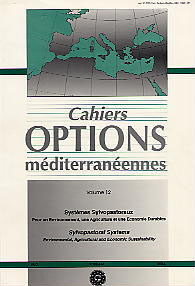| Article précédent | p. 161-164 | Article suivant |
Le sylvopstoralisme en Tunisie
The State forest domain covers about 900.000 ha. It consists of natural forests, man made forests, maquis, garrigue (shrubs) and nape of Stipa tenacessima. The principal forest species are Pinus halepensis, Quercus suber, Quercus faginea, Pinus pinaster and Juniperus phoenicia. The forest code regularises the management of pasture land (rangeland) in the State forest domain, and allows the pasture resources to be exploited free of charge by the forest citizens. The total livestock occupying this land is estimated at 1,255,600 animals. The ratios are as follows 59 per cent sheep, 26 per cent goats, 10 per cent cattle and 5 per cent other species. In Kroumirie and Mogods, in the North of Tunisia, the livestock grazes all year round in the forest, but in the Haut Tell and the Dorsale on average 6 months for sheep and goats, 5 months for cattle and 4 months for equine. The annual need of the total livestock is 158 millions feed units. The annual production capacity of the forest grazing land is estimated at 125 millions feed units. Bearing in mind that, annually, only 70 per cent of the total pasture land is used for grazing. The young plantation, forest regeneration and incinerated forests which represent about 30 per cent are automatically excluded from grazing. The consequences of fodder deficit and the overgrazing which characterise most of the State forest domain results in degradation of vegetation cover and the unbalanced sylvopastoral environment.
- [ Afficher ]
- [ Télécharger ]
- [ Exporter la citation ]
Vous pouvez télécharger la citation au format :
- [ Imprimer ]
-
Mots-clés
ALIMENTATION DES ANIMAUX, DEGRADATION, SYSTEME SYLVOPASTORALCiter cet article
El Euch F. Le sylvopstoralisme en Tunisie. Systèmes sylvopastoraux. Pour un environnement, une agriculture et une économie durables . Zaragoza : CIHEAM, 1995. p. 161-164. (Cahiers Options Méditerranéennes; n. 12). Réunion du Groupe de Travail Méditerranéen du Réseau Interrégional FAO/CIHEAM de Recherche et Développement sur les Pâturages et les Cultures Fourragères, 1995/05/29-1995/06/02, Avignon (France). http://om.ciheam.org/om/pdf/c12/96605510.pdf



